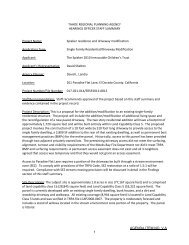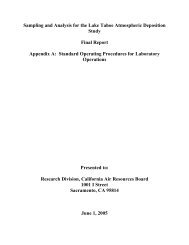FEIS - Tahoe Regional Planning Agency
FEIS - Tahoe Regional Planning Agency
FEIS - Tahoe Regional Planning Agency
You also want an ePaper? Increase the reach of your titles
YUMPU automatically turns print PDFs into web optimized ePapers that Google loves.
RESPONSE TO COMMENTS ON THE DEIS<br />
B o u l d e r B a y C o m m u n i t y E n h a n c e m e n t P r o g r a m P r o j e c t E I S<br />
Please see the response to comment 322-c. Although the number of residents and<br />
guests increases, the amount of energy consumption decreases due to greater use<br />
efficiency. The existing structures are old, poorly designed in comparison to modern<br />
energy efficiency models, and do not include energy efficient appliances and building<br />
materials (windows, insulation, roofing, heat transfer systems, etc.). Because the<br />
existing facilities are highly energy inefficient, replacement of the structures with<br />
more efficient units resulting in energy savings.<br />
Comment 322-aw: Comment Summary - Need to include energy consumption during construction and<br />
for the snowmelt system and analyze how the project reaches LEED certification.<br />
Please see responses to comments 93-u, 112-a, 286-as, and 313-f.<br />
Comment 322-ax: Comment Summary - What is the impact of road realignments and road<br />
abandonment under Alt. C?<br />
Please see response to comment 93-q.<br />
Comment 322-ay: Comment Summary - Analyze the proximity to services for work force and lowincome<br />
housing and the overall increased project density.<br />
The proximity of public services is shown in Chapter 4.12. Although there are not a<br />
large number of commercial services available in Crystal Bay, the NSCP indicates a<br />
need for affordable and employee housing and therefore, it is prudent to provide such<br />
housing under this Project. A transit stop is located at the Project site to improve<br />
access to other retail/commercial centers.<br />
Comment 322-az: Comment Summary - Analyze the availability of off-site work force and low-income<br />
housing and the environmental trade-offs of off-site vs. onsite options.<br />
Available off-site workforce and housing are described in the analysis of Chapter<br />
4.11 on pages 4.11-12 through 13. The impacts from onsite housing and additional<br />
employees are analyzed in SPH-2 and 3 as well as through the analysis in the other<br />
analysis Chapters (Chapters 4.1 through 4.12. Impacts from employees living offsite<br />
are also analyzed in these chapters. It is not required to analyze conditions not<br />
proposed by the Project.<br />
Comment 322-ba: Comment Summary - The DEIS considers 69 different impacts, but this isn't enough<br />
and additional impacts should be included.<br />
The DEIS considers each of the impacts listed in the TRPA Environmental Checklist.<br />
Impact topics not applicable to the Project are noted for each evaluation criteria table<br />
in Chapter 4 (see Table 4.2-4 for an example). In other comments, the commenter<br />
indicates that the analysis fails to include basin capacity for residential units, TAUs,<br />
CFA and recreational uses. These are analyzed within Chapters 4.1 and 4.6. With<br />
units existing and transferred to the site, new capacity is not created except for bonus<br />
units, which is permissible under TRPA regulations. Other comments indicate the<br />
analysis fails to include an assessment of energy consumption. Energy consumption<br />
is addressed in Chapter 4.12 (see impact PSU-1), and includes the ARUP energy<br />
consumption study (please see responses to comments 322-c, 322-e, and 322-f).<br />
LEED silver certification is feasible as indicated by the LEED pilot project checklist<br />
(please see response to comment 322-f). The commenter also indicates the DEIS<br />
fails to analyze road realignments and abandonment, proximity to services for<br />
employee housing, and the environmental trade-off of onsite vs. off-site employee<br />
housing. Road realignments and abandonments are discussed in Chapter 4.8.<br />
Changes to the roadways conform to Washoe County standards, including issues<br />
PAGE 8- 92 HAUGE BRUECK ASSOCIATES SEPTEMBER 8 , 2010






